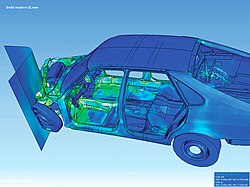
Back طريقة محدودة العناصر Arabic طريقة لعناصر لمنتهية ARY Sonlu elementlər üsulu Azerbaijani Метод на крайните елементи Bulgarian Anàlisi d'elements finits Catalan Metoda konečných prvků Czech Finite-Elemente-Methode German Μέθοδος πεπερασμένων στοιχείων Greek Método de los elementos finitos Spanish Lõplike elementide meetod Estonian

| Differential equations |
|---|
| Scope |
| Classification |
| Solution |
| People |
The finite element method (FEM) is a popular method for numerically solving differential equations arising in engineering and mathematical modeling. Typical problem areas of interest include the traditional fields of structural analysis, heat transfer, fluid flow, mass transport, and electromagnetic potential. Computers are usually used to perform the calculations required. With high-speed supercomputers, better solutions can be achieved, and are often required to solve the largest and most complex problems.
The FEM is a general numerical method for solving partial differential equations in two or three space variables (i.e., some boundary value problems). There are also studies about using FEM solve high-dimensional problems.[1] To solve a problem, the FEM subdivides a large system into smaller, simpler parts called finite elements. This is achieved by a particular space discretization in the space dimensions, which is implemented by the construction of a mesh of the object: the numerical domain for the solution, which has a finite number of points. The finite element method formulation of a boundary value problem finally results in a system of algebraic equations. The method approximates the unknown function over the domain.[2] The simple equations that model these finite elements are then assembled into a larger system of equations that models the entire problem. The FEM then approximates a solution by minimizing an associated error function via the calculus of variations.
Studying or analyzing a phenomenon with FEM is often referred to as finite element analysis (FEA).
- ^ Hoang, Viet Ha; Schwab, Christoph (2005). "High-dimensional finite elements for elliptic problems with multiple scales". Multiscale Modeling & Simulation. 3 (1). SIAM: 168–194. doi:10.1137/040606041 (inactive 2024-11-02).
{{cite journal}}: CS1 maint: DOI inactive as of November 2024 (link) - ^ Daryl L. Logan (2011). A first course in the finite element method. Cengage Learning. ISBN 9780495668275.